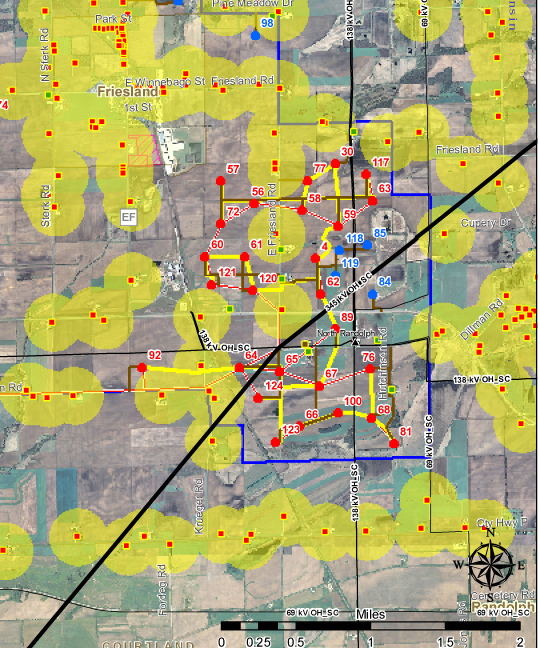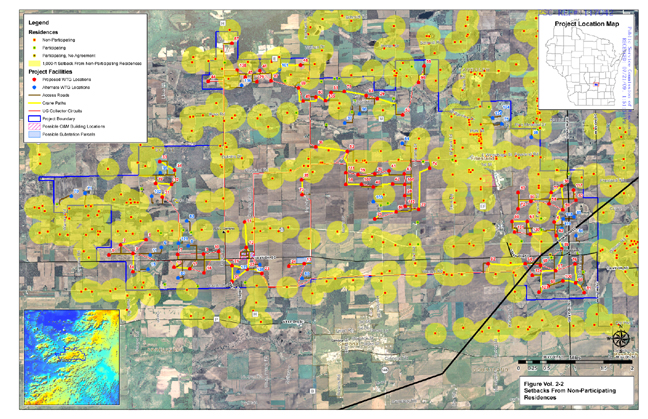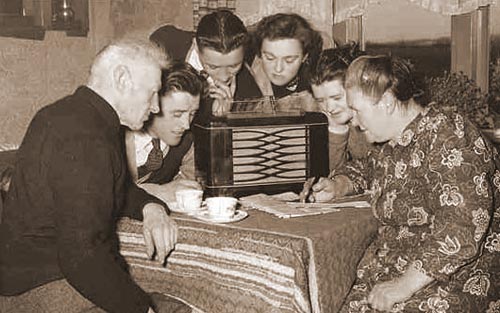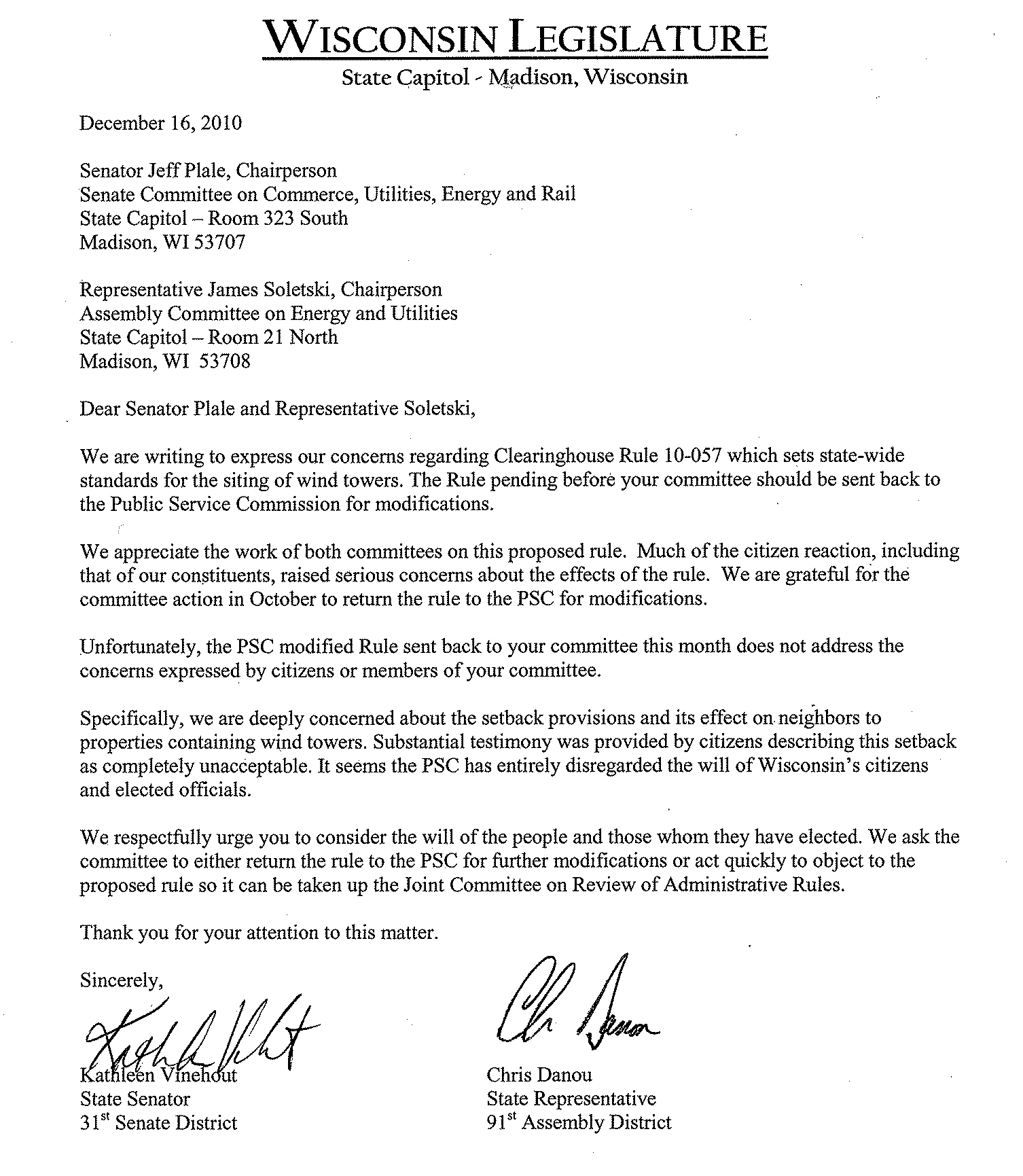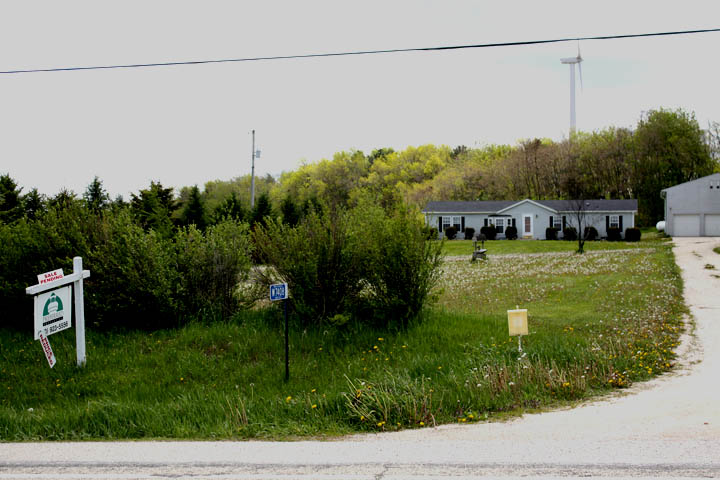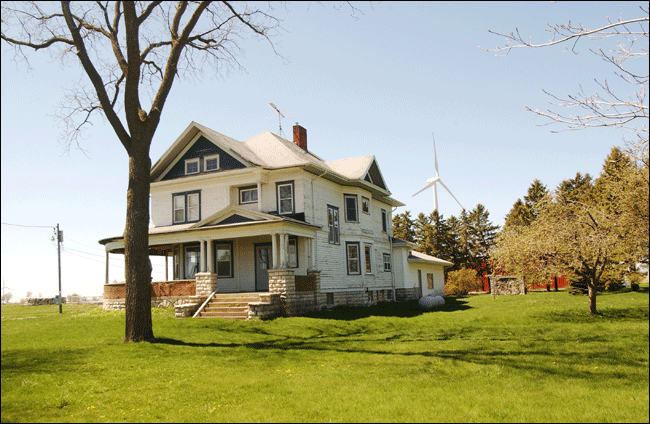Entries in Columbia County (13)
3/31/11 Local elections tied to wind development in Brown County AND Big wind lawsuit in little St. Croix county AND Wind Whirl over cancelled projects: How much of it is spin? AND Wind blade factory falls through: carrot on end of stick could have been a mirage AND Hello Windmill, Bye Bye Birdie
WIND FARMS REMAIN AN ISSUE IN GLENMORE, MORRISON
Source: Green Bay Press Gazette
March 31, 2011
By Doug Schneider
Wind farms remain a campaign issue in two southern Brown County towns, despite a company's recent decision to cancel plans for 100 wind turbines in Morrison, Glenmore and other nearby communities.
Invenergy LLC said it would not pursue permits for a wind farm in the area, but campaign signs related to wind energy continue to dot the landscape, and candidates say they still need to be prepared with future proposals that could affect residents' quality of life.
"We have to keep in mind that there are other projects like this out there, smaller developments," said Todd Christensen, who is seeking re-election as Morrison town board chairman, "and there could be more in the future."
Invenergy would have put 54 turbines in Morrison, four in Glenmore, and others in Wrightstown and Holland. Because some town officials expect there will be other developments proposed, towns are banding together to push for consistent regulations on issues related to windmills, and are asking state officials to consider their concerns. A handful of wind turbines were built as part of another project off Wisconsin 96 near the hamlet of Shirley.
But candidates also say there are issues beyond wind-energy regulation.
Cliff Hammond, who is challenging Christensen, said the next town board also will need to work to maintain a balanced budget as financial support from the state and county decline.
Kriss Schmidt, who is running for board chairperson in Glenmore, said board members will have to make sure basic services like snowplowing and road-patching are maintained.
Pat Kolarik, who also is running for Glenmore board chair, said the key for elected officials will be to focus on maintaining residents' quality of life whether the issue is wind energy or something else.
"There are going to be a number of challenges we have to address — budget, services, appropriate setbacks for any structure," she said. "The goal for me would be to work with residents on appropriate solutions."
ENERGY SOLUTION OR LEGAL TROUBLE?
March 31 2011
"The controversial energy project in Forest has come under fire and may be stopped by a federal lawsuit which was filed by a citizens’ group in February."
A legal battle in northeastern St. Croix County highlights the difficult issues of wind-generated power. Talk to anyone and they will, in general terms, talk about wind power as a good, efficient and cheap energy source for the times — be it today or tomorrow.
Try finding a location to construct wind generators and suddenly you’ve got yourself a first-class controversy, complete with arguments among neighbors, recalls and lawsuits.
Such is the case in St. Croix County in the town of Forest.
The controversial energy project in Forest has come under fire and may be stopped by a federal lawsuit which was filed by a citizens’ group in February. That suit was also supported by action of a new town board that was elected through a successful recall election. The former board had approved the proposed wind energy project last summer.
A citizens’ lawsuit was filed in February. In March, the new town of Forest board voted to rescind a wind energy development agreement and other approvals that had been granted to a wind developer. The project, being proposed by a private developer named Emerging Energies, is in jeopardy.
The project in Forest called for 39 wind towers. Each tower stands about 500 feet tall.
Many landowners in the town had signed leases with the wind firm, but were prohibited from discussing the project. When the rest of the town’s residents got “wind” of the deals, the uprising began.
Now there are battles over setbacks, noise, quality of life, health, property value, safety and more. Emerging Energies, LLC, has also threat-ened the new town board with legal action.
A similar scenario developed in the eastern part of the state when a Chicago wind energy developer, Invenergy LLC, dropped its plan to build a large wind farm near Green Bay.
Opponents in the Green Bay area are expressing the same concerns and claim they will continue to work to prevent the “irresponsible development of industrial wind projects.”
State energy regulators are now trying to come up with a plan to help support wind projects. Regulators may be asked to go back to the drawing board to develop statewide rules governing wind power projects, under a bill to be considered this week.
The Legislature’s joint committee for review of administrative rules voted earlier this month to temporarily block a wind farm site rule developed by the state Public Service Commission.
Supporters of wind energy development say legal problems will stall development, leading to a loss of jobs tied to wind turbine construction as well as revenue for host property owners and local governments. There seems to be plenty of controversy over, among other things, setbacks for wind towers.
A property rights bill introduced by Gov. Scott Walker in January would restrict wind towers from being placed less than 1,800 feet from a property line. That bill had the apparent support of wind farm opponents and the Wisconsin Realtors Association.
In its most recent wind farm decision, the PSC ruled that 1,250-foot setbacks be required for We Energies’ Glacier Hills Wind Park, now under construction in Columbia County.
The bottom line is, when wind towers begin popping up in either populated areas, or rural countryside, there is likely to be plenty of opposition. A group of wind towers doesn’t do much for the scenic value of any topography.
Despite all the virtues of wind power, developing a power source to a degree where it would have a significant impact could be difficult when facing “not in my backyard” neighborhoods.
MIDWEST WIND SUSPENDS DEVELOPMENT WORK IN STATE
"Wind industry representatives said the PSC rule was restrictive because it set specific decibel limits for turbine noise and shadow flicker restrictions as well as setbacks."
March 31, 2011
By Thomas Content
Midwest Wind Energy is suspending development of two wind farms in Wisconsin, the Illinois company said Wednesday.
The company developed the Butler Ridge wind farm in Dodge County and the Cedar Ridge project in Fond du Lac County, projects now owned and operated by other companies.
Midwest Wind said it was actively working on a 98-megawatt wind farm in Calumet County and another project for which a location had not yet been announced.
Midwest Wind cited development opportunities in other states at a time when Wisconsin policymakers are moving to restrict wind farm development.
"Most states are clearly open for renewable energy development and the economic development dollars and jobs that come with it,” said Stefan Noe, company president. “So long as there are states rolling out the welcome mat it doesn't make sense to devote significant dollars to a state that is creating unreasonable roadblocks for wind development."
The action came one week after Invenergy of Chicago canceled plans to develop a large wind farm near Green Bay, and one day after a legislative committee voted to introduce a bill sending wind siting rules back to the state Public Service Commission for more work.
Republican lawmakers and Gov. Scott Walker have said the PSC rule allowed turbines to be built too close to nearby homes. Wind industry representatives said the PSC rule was restrictive because it set specific decibel limits for turbine noise and shadow flicker restrictions as well as setbacks.
A bill that passed in the Legislature two years ago called on the PSC to set up a uniform standard for wind projects across the state, to replace a patchwork of local rules and moratoriums that were in place with regard to wind projects.
Keith Reopelle, senior policy director at the environmental group Clean Wisconsin, said the new chair of the PSC, Phil Montgomery, was a co-sponsor and supporter of the bill that called on the PSC to set statewide standards. He said he hoped the agency would move quickly to develop a workable set of rules.
When the bill was introduced in 2009, Montgomery – then a state lawmaker from Brown County and ranking Republican on the Assembly energy and utilities committee - released a statement in support of a uniform state standard.
“Wind power is job-creating power,” Montgomery said in April 2009. “A fair and uniform state standard for siting wind developments will create an environment of investment in our state while moving us closer to our green energy goals.”
WIND TURBINE PLANT ON HOLD
Source: Wisconsin Rapids Daily Tribune
March 31, 2011
By Nathaniel Shuda
"I think we had to give them every opportunity to succeed," council member Lee Albrecht said. "You have this carrot dangling out there that there are 600 jobs on the horizon; I think you have to do whatever you can to have that carrot come to you."
Wisconsin Rapids is ready to buy back land it sold to a local company that two years ago announced plans to build a wind-turbine blade manufacturing plant on the property.
Energy Composites Corp. faces a Friday deadline to either reach an agreement with Wisconsin Rapids or sell the nearly 94 acres of land back to the city at the original purchasing price, Mayor Mary Jo Carson said.
Carson said the sale doesn't necessarily mean the project is dead, but it won't happen right now.
"Obviously, ECC doesn't want to hold us up in reference to that land, which we thank them for," she said. "We appreciate their interest in their hometown."
Carson said City Attorney Sue Schill has been working with the company's attorney to reach a buy-back agreement.
On March 31, 2009, the company announced plans to build a 350,000-square-foot plant in the Rapids East Commerce Center that would create at least 400 local jobs. Since then, those plans expanded to 535,000 square feet and more than 600 positions.
To facilitate the project, the city later sold the Wisconsin Rapids-based company 93.7 acres of land in the Rapids East Commerce Center for $500 an acre -- a 90 percent discount from the typical asking price -- plus a $1,000 option fee, for a total price of $47,850.
Under the pending agreement, the city would buy back the land at the same price for which it sold it, Carson said.
"I'm glad to see it being sold back to the city at the original price," City Council member Marion Hokamp said. "The sooner they do it, the better it's going to be. Maybe we're going to get somebody else interested (in the property)."
As part of the original development agreement, the city would have paid $1.5 million for infrastructure costs, including extending city streets and expanding railroad access to the property, and $6,000 for each full-time job the company created on or before Dec. 31, 2012, up to $3.8 million.
At this point, Wisconsin Rapids has not invested any money in the project, city Finance Director Tim Desorcy said.
A decline in bond market conditions led company officials to put the project on hold while they searched for investors. Those efforts have been unsuccessful.
Hokamp, who has publicly criticized Energy Composites for a lack of action, said the city should have bought the property back sooner. She remained skeptical of the project throughout the process.
"Way back when they started, I never thought it was going to be done," she said. "They knew they weren't going to have anything out there a long time ago."
Other council members do not regret giving the company so long to bring the plan to fruition.
"I think we had to give them every opportunity to succeed," council member Lee Albrecht said. "You have this carrot dangling out there that there are 600 jobs on the horizon; I think you have to do whatever you can to have that carrot come to you."
WIND FARMS THREATEN MANY BIRD SPECIES WITH EXTINCTION
SOURCE Save The Eagles Foundation
STEI's president, Mark Duchamp, objects to the wind industry comparing bird mortality at windfarms to that from other causes related to human activities. These other threats have already reduced bird populations worldwide, he said, and are continuing to do so.
"But mortality caused by windfarms and their power lines is new and additional", he adds, "and like the proverbial last drop that spills the glass, its effects will be upsetting.
To wit the Tasmanian Wedge-tailed Eagle, which has been condemned to extinction by the construction of 7 windfarms in its habitat" (1).
Another important difference, says Duchamp, is that the other threats can't be easily stopped, whereas poorly-sited windfarm projects can. The Spanish Ornithological Society (SEO/Birdlife) recommended this month that windfarms no longer be built in natural areas, but in urban and industrial areas instead (2).
One week later, SEO/Birdlife revealed that bird mortality caused by windfarms and power lines was much higher than previously thought. For the Spanish region of Castilla La Mancha, they estimate it to be "1.3 million birds a year, many of them in danger of extinction like the Imperial Eagle, the Bonelli´s Eagle or the Lesser Kestrel". And they added: "(this is) a considerable number which proves that windfarms have a great capacity for killing birds". (3)
"This is what I have been claiming for 9 years", says Duchamp, "but only this month did SEO recognize the danger. During all that time I have been treated as a heretic, and was banned from ornithology forums where my whistle-blowing was causing discomfort in the profession."
The French naturalist, who lives in Spain, has been vindicated at last. He praises the American Bird Conservancy, Birdlife Bulgaria, and SEO for their firm stand against improperly sited windfarms, but laments that it will take more years before the most prominent bird societies do likewise. Conflicts of interests are at the root of the problem, he says.
STEI warns that, if we are to save our emblematic bird species from this new threat, it is urgent to impose a moratorium on windfarm construction and to call for a really independent commission to investigate the whole windfarm matter, starting with the effectiveness of this intermittent, unreliable, and ruinous form of energy.
Duchamp founded Save the Eagles International in 2009, to raise awareness and to publish inconvenient bird mortality statistics that most bird societies fail to make available to the public. He has launched today the STEI website where these numbers and their sources can be found:
REFERENCES
(1) - Wind farms: suspicious error by consultant condemns Tasmanian eagle to extinction.
(2) - SEO Birdlife: " Castilla-La Mancha "debe abandonar el viejo modelo de grandes centrales de generación eléctrica situadas en plena naturaleza y alejadas de los puntos de consumo y fomentar la generación eléctrica en suelo urbano e industrial".
Translation: "Castilla-La Mancha "must abandon the old model of large power plants located in natural habitats, far away from where the energy is consumed, and promote electrical generation in urban and industrial zones."
(3) - SEO Birdlife: "1,3 millones de aves al año... un número considerable con el que se demuestra que los parques eólicos tienen «una gran capacidad para matar aves»."
Translation: "1.3 millon birds a year... a considerable number which proves that windfarms have a great capacity for killing birds "
1/25/11 UPDATE ON HERE COMES THE JUDGE: All eyes on Ontario as safety of wind developer-friendly setbacks are challenged in court AND The latest on the Wind Farm Strong Arm: Date is set for wind developer's lawsuit against a rural community AND What is wrong with this picture? Our Big Wind video of the day
WHAT'S AT ISSUE WITH GOVERNOR WALKER'S WIND SITING BILL:
Pictured Above: Setbacks between 400 foot tall wind turbines and homes in a PSC-approved wind project Fond du Lac County Wisconsin. The yellow circles indicate the 1000 foot safety zone around each turbine.
Pictured Below: PSC approved Glacier Hills Wind Project under constrution in Columbia County. In this map from WeEnergies, red dots are turbine locations. Each yellow circle containing a small red square is a non-participating home.
When they permitted the wind project, the PSC admitted that there were too many turbines around some homes but instead of asking for fewer turbines in those areas they asked the wind company to offer to purchase the homes. They did.
The PSC wind rules allow safety zones to cross property lines and allow a wind company to automatically use a neighbor's land as part of that safety zone. This creates a no-build and no tree planting zone on the property of a non-particpating land owner who must to get permission from the wind company to build a structure or plant a tree on his own land.
Senate Bill 9 helps to correct this problem.
The PSC statewide siting rules are to take effect on March 1st, 2011. They have setbacks of 1250 feet between homes and a 500 foot turbine. The rules allow a wind company to use a non participating landowner's property as a safety setback zone.
Senate Bill 9 increases the setback to 1800 feet between turbines and property lines. If a landowner wants a turbine closer he can enter into an agreement with the wind company. This bill gives some choice and a little more protection to the rural Wisconsin families who have no choice about living beneath the turbines.
PICTURED ABOVE: a map showing the noise level predicted for residents in Invenergy's proposed Ledge Wind Project in Brown County. The yellow dots are homes. The black dots are wind turbine locations. The World Health Organization says nighttime noise should no louder than 35 dbA for healthful sleep. The deep blue areas indicate predicted turbine noise levels above 50 dbA. The purple areas indicate turbine noise levels of 50dbA.
SUPPORT SENATE BILL 9: WALKER'S WIND SITING REFORM
Better Plan encourages you to take a moment right now to contact Governor Walker's office to thank him for the provisions in Senate Bill 9, (CLICK HERE TO DOWNLOAD THE BILL) which provides for a setback of 1800 feet between wind turbines and property lines. Let him know you support this bill.
CONTACT Governor Scott Walker govgeneral@wisconsin.gov
115 East Capitol
Madison WI 53702
(608) 266-1212
RED ALERT!
It's very important that you contact these key legislative committee members and urge them to support this bill and vote to move it forward. Every phone call and email to these committee members matters.
Members of the Senate Committee on Judiciary, Utilities, Commerce, and Government Operations.
-Chairman Senator Rich Zipperer (R) Sen.Zipperer@legis.wisconsin.gov
(608) 266-9174 Capitol 323 South-Vice Chair Senator Neal Kedzie (R) Sen.kedzie@legis.wisconsin.gov
(608) 266-2635 Capitol 313 South-Senator Pam Galloway(R)
Sen.Galloway@legis.wisconsin.gov
(608) 266-2502 Capitol 409 SouthSenator Fred Risser (D) Sen.risser@legis.wisconsin.gov
(608) 266-1627 Capitol 130 SouthSenator Jon Erpenbach (D) Sen.erpenbach@legis.wisconsin.gov
(608) 266-6670 Capitol 106 SouthAssembly Committee on Energy and Utilities
Representative Mark Honadel (Chair)(888) 534-0021 (414) 764-9921 (South Milwaukee)
Rep.Honadel@legis.wisconsin.gov
Representative John Klenke (Vice-Chair)(888) 534-0088 (Green Bay) new
Rep.Klenke@legis.wi.gov
Representative Kevin Petersen(888) 947-0040 (Waupaca)
Rep.Petersen@legis.wisconsin.gov
Representative Gary Tauchen(608) 266-3097 (Bonduel)
Rep.Tauchen@legis.wisconsin.gov
Representative Thomas Larson(888) 534-0067 (Colfax) new
Rep.Larson@legis.wi.gov
Representative Erik Severson(888) 529-0028 (Star Prairie) new
Rep.Severson@legis.wi.gov
Representative Chad Weininger(888) 534-0004 (Green Bay) new
Rep.Weininger@legis.wi.gov
Representative Josh Zepnick(608) 266-1707 (414) 727-0841 (Milwaukee)
Rep.Zepnick@legis.wisconsin.gov
Representative John Steinbrink(608) 266-0455 (262) 694-5863 (Pleasant Prairie)
Rep.Steinbrink@legis.wisconsin.gov
Representative Anthony Staskunas(888) 534-0015 (414) 541-9440 (West Allis)
Rep.Staskunas@legis.wisconsin.gov
Representative Brett Hulsey(608) 266-7521 (Madison)
Rep.Hulsey@legis.wi.gov
And be sure to contact your own legislators and encourage them to support the bill.
THE LATEST ON THE ONTARIO WIND LAWSUIT:
UPDATED JANUARY 24, 2011
ONTARIO LAWYER CHALLENGES CREDIBILITY OF LEADING WITNESSES IN CHALLENGE TO WIND FARM LAW
Read it at the Source: Ottawa Citizen
January 24, 2010
By Lee Greenberg
TORONTO — An Ontario government lawyer attacked the credibility of three star witnesses in a key legal challenge to the province’s new green energy legislation.
Sara Blake said Dr. Robert McMurtry and two other physicians, who cast doubt on the safety of wind turbines, are not reliable witnesses.
The three are named as experts in the case brought against the government by Prince Edward County property owner Ian Hanna. Hanna and his fellow anti-wind campaigners believe turbines emit low-frequency noise that lead to a range of health problems, including sleep deprivation, stress, chronic depression and even cardiovascular disease.
The case is the first major test of new regulations introduced in September 2009, four months after the province passed its Green Energy Legislation. According to those new rules, wind turbines will have to be placed a minimum of 550 meters from the nearest home.
That “setback” is at the centre of Monday’s court challenge.
Hanna and his backers say the government failed to fully examine the medical studies on the health affects of turbines. The government denies the claim.
Blake says McMurtry, an orthopedic surgeon and former medical school dean who also has advised the federal government on health policy, is neither an expert on the issue of noise emissions nor is he impartial.
He and the other two doctors cited in the court challenge all took an interest in wind turbines because they were being built near their homes, the prosecutor said. (McMurtry, who is the brother of former Ontario chief justice and attorney general Roy McMurtry, owns property in Prince Edward County and is the founding member of an anti-wind group there).
Blake said McMurtry expresses opinions in a deposition that he is not qualified to give.
“This is pure advocacy,” she told a three-member panel at Osgoode Hall in Toronto Monday. “He is not an expert ... It is the belief of a passionate person.”
She also cast aspersions on the study of Dr. Michael Nissenbaum, who concluded people living within 1.1 kilometres of a wind farm in Maine suffered numerous health affects, including hearing problems, increased psychiatric symptoms and overall increased use of prescription medication.
The study is not published and is not peer reviewed, she said.
Eric Gillespie, the lawyer for Hanna and the anti-wind advocacy group behind him, contends that the rule placing turbines 550 meters from the nearest house was made without sufficient scientific evidence.
But under questioning from the three judges hearing the case, Gillespie acknowledged the science is inconclusive on the health effects of turbines.
He also takes issue with the fact that a planning expert — and not a public health expert — reviewed the science on the impacts of turbines.
“On a matter of human health it is not enough to have a land use planner say we considered it,” he said in court.
Gillespie also withdrew a request for an injunction on all new wind farms in Ontario. He is asking the court to strike down regulations laying out the 550-meter setback. It is unclear what sort of temporary regulations would emerge if he is successful in the request.
It is unknown when — if at all — the court will issue a decision on Monday’s one-day hearing.
While the three judges listened to arguments, they are also considering an argument by the attorney general that the case should be sent to an environmental tribunal.
Previous story:
The Green Challange
SOURCE: Owen Sound Sun Times
January 24, 2011
Jonathan Sher
Ian Hanna has asked an Ontario court to strike down part of the province's Green Energy Act, enlisting doctors who argue human health was compromised when the act created a buffer of only 550 metres between wind turbines and homes.
* If Hanna prevails, the burgeoning wind industry could grind to a halt until medical studies are done.
* The lobby group for the wind industry has intervened in the case.
* The Ontario government dismisses medical claims as irrelevant and says Hanna doesn't have a legal basis for a challenge.
* Three judges in Toronto will hear evidence Monday and Tuesday.
- - -
Health effects
Several doctors are saying turbines emit low-pitched sounds that disrupt the body's normal rhythms and cause ailments including:
* Headaches
* Irritability
* Problems with concentration and memory
* Dizziness
* Tinnitus
* Rapid heart rate
* Nausea
- - -
'The right thing to do'
Last week Free Press Reporter Jonathan Sher spoke with the Prince Edward County man who sought the judicial review, Ian Hanna, and his Toronto lawyer, Eric Gillespie. Below are excerpts of their conversation:
Q Prior to getting involved with wind turbines had you been involved with environmental issues or activism?
Hanna: No to both questions.
Q You never led petitions before, subscribed to newsletters on environmental issues or tried to interject yourself into public debate?
That's absolutely correct.
Q What things attracted you to move to Big Island from the GTA?
The idea of a more rural atmosphere appealed to us. The openness, the stars, the birds. You have to come here sometime and walk outside on a summer's afternoon. It's just unbelievable.
Q What about adverse health effects of wind turbines?
People appear to be emotionally drained, unable to really function on a calm, natural basis. We know people can't sleep properly at all when they are close to industrial wind turbines . . . They appeared to be very tortured by the effects.
Q Why did you continue to pursue the case even though your home and Big Island no longer in harm's way?
Because it's the right thing to do. I have three children who if I gave them nothing else . . . I think I at least gave them the strength or assisted them with gaining the strength to stand up for what they believe in and for what's right.
Q How has the legal action been financed?
We put every cent we could put in to it so far and if we have to put more, we'll find it . . . 100% of the money that's been contributed has come from people just like us, other families all over Ontario . . .
Q How much has been raised so far? Ballpark?
Close to $200,000
Q How are you feeling as you head toward the hearing in Toronto?
I'm excited, I'm confident, I'm grateful for the incredible capable way it's been handled . . . and to be really fair I'm exceedingly sad and disappointed . . . It's all been based on facts and realities and truths coming from just regular people like myself who have no axe to grind with anybody beyond the fact that we're frightened by the potential of this, yet, the other side has done one thing and one thing only: They've circled their wagons.
WIND ON TRIAL
A burgeoning billion-dollar industry and the political fortunes of Dalton McGuinty's Liberals may turn on a legal challenge by a single man whose day in court arrives Monday.
Ian Hanna lives far away from the corridors of power in Queens Park and Bay Street in a century-old farmhouse on Big Island in Prince Edward County. But Monday he finds himself in the epicentre of a debate that could shape the economic future of the province and the political fate of the ruling Liberals.
It's a fight over wind turbines that have been rising across Ontario with ever greater frequency, an industry the Liberal government has subsidized with plans to double its energy capacity in this year alone.
But those plans in Queens Park -- really the heart of the Green Energy Act -- were placed in judicial crosshairs 15 months ago. That's when Hanna, 58, challenged a provision that creates a buffer of only 550 metres between turbines and homes.
Several doctors have lined up behind Hanna's challenge, saying turbines emit low-pitched sounds that disrupt the body's normal rhythms and cause ailments including headaches, tinnitus, dizziness, nausea, rapid heart rate, irritability and problems with concentration and memory.
Those concerns have been dismissed as irrelevant by lawyers representing the Ontario government, who instead will try to convince three judges in Toronto that Hanna doesn't have a legal basis for his claim -- that there is no provision in the Green Energy Act itself or elsewhere that allows a citizen to challenge a regulation.
The dismissive approach concerns Hanna's lawyer Eric Gillespie.
"That's been a significant concern for all the experts that are part of this process on behalf of Mr. Hanna. These are medical doctors from Ontario, the United States and England, all of whom have seen what they believe to be first-hand sufficient evidence to say that industrial wind turbines do pose a very real risk to residents," Gillespie said.
Gillespie is an environmental lawyer who cases include one that landed a $36-million award since appealed.
The government's decision to object solely on procedural grounds worries the wind industry that over the next 20 years has planned about $20 billion in investments that would be subsidized by Ontario taxpayers.
A lawyer for the Canadian Wind Energy Association declined to comment about Hanna's case but did provide a copy of its written arguments.
An Ontario Environment Ministry spokesperson defended the Green Energy Act.
"Our process is based on science, modelling and jurisdictional comparisons. It will be protective of public health and the environment," Kate Jordan said.
Read more about the Ian Hanna Legal Challenge:
Application for Judicial Review against the Ontario government goes to court Jan. 24-25
Second Feature:
JUDGE SETS ECOGEN, PRATTSBURGH HEARING
SOURCE Bath Courier, www.steubencourier.com
January 23, 2011
By Mary Perham,
Prattsburgh, NY — A court hearing has been set for Jan. 27 to learn more details about the events behind a year-long lawsuit between the town of Prattsburgh and a wind farm developer.
The hearing will resolve some issues and lead to a final decision in the dispute between the town and the developer, Ecogen, according to state Supreme Court Justice John Ark.
Ark wants sworn testimony from former town officials, including Attorney John Leyden and Supervisor Harold McConnell, Ecogen representatives and other town officials.
Questions appear to pinpoint Ecogen’s contention that it has been ready to set up 16 turbines for more than two years and questions Ecogen’s claim it had “vested rights” by late 2008.
Ecogen also claims board members have stymied the builder’s efforts to proceed with the project.
“Which is funny, when they’re on record telling the Town of Italy, Prattsburgh has been very cooperative throughout,” said Prattsburgh’s attorney Ed Hourihan.
Hourihan said the town is pleased to see the judge has narrowed the issues to “specifically pin down Ecogen’s ever changing position. Since this litigation has started, Ecogen had changed its position so many times its hard to tell what is the truth.”
Hourihan said he will question the witnesses and can present evidence proving any testimony is incorrect.
Last fall Ark said he was close to a decision in the case, but urged Ecogen and the town to meet and find an out-of-court compromise.
Town officials offered to provide other sites for the proposed turbines, but Ecogen maintained the December 2009 agreement was binding and refused to compromise.
An offer to meet with Prattsburgh by Ecogen’s parent company, Pattern, apparently fell through last month, current town Supervisor Al Wordingham said.
Wordingham said he called Pattern representative John Galloway just before Christmas to follow up on several phone conferences and a plan to meet.
“He told me he had some internal issues to resolve,” Wordingham said.
Galloway has not returned his final call, Wordingham told residents at the town board meeting Monday night.
“And we still don’t have their final site map,” Wordingham said.
In related action, the board held a public hearing on extending their moratorium on tower construction another six months. Several residents said they supported the moratorium, although they thought six months was too long.
The board will vote on the moratorium during their regular Feb. 22 meeting.
FROM OUR 'WHAT IS WRONG WITH THIS PICTURE?' VIDEO FILE-- Or Why aren't those turbines turning?
AND: What they're finding out about big wind in Taiwan
12/20/10 Radio Radio: Listen to wind rules discussed on WORT'S 'A Public Affair' AND! This Just In: Yet another letter from legislators to Senator Plale asking him to object to the wind rules BUT Is there a mailbox in his spider hole?
EXTRA CREDIT READING:
CLICK HERE for Clean Wisconsin's 2009 testimony to the Public Service Commission during the Glacier Hills Wind Project hearings--Clean Wisconsin tells the PSC there will no CO2 reduction because of the implementation of the Glacier Hills project unless the PSC also requires a coal fired plant to be shut down.
Result: The PSC approves the project with no requirement that a coal-fired plant to be shut down.
12/7/09 Clean Wisconsin lives up to its name by taking on the dirty elephant in the room.
December 16, 2010
Dear Senator Plale and Representative Soletski,
We are writing to express our concerns regarding Clearinghouse Rule 10-057 which sets state-wide standards for the siting of wind towers.
The Rule pending before your committee should be sent back to the Public Service Commission for modifications.
We appreciate the work of both committees on this proposed rule. Much of the citizen reaction, including that of your constituents raised serious concerns about the effects of the rule. We are grateful for the committee action in October to return the rule to the PSC for modifications.
Unfortunately, the PSC modified Rule sent back to your committee this month does not address the concerns expressed by citizens of members of your committee.
Specifically, we are deeply concerned about the setback provisions and its effect on neighbors to properties containing wind towers. Substantial testimony was provided by citizens describing this setback as completely unacceptable.
It seems the PSC has entirely disregarded the will of Wisconsin's citizens and elected officials.
We respectfully urge you to consider the will of the people and those whom they have elected. We ask the committee to either return the rule to the PSC for further modifications or act quickly to object to the proposed rule so it can be taken up the Joint Committee on Review of Administrative Rules.
Thank you for your attention to this matter,
Sincerely,
Kathleen Vinehout
State Senator
31st Senate District
Chris Danou
State Representative
91st Assembly District
11/16/10 Columbia County traffic jam
WIND FARM WORK TO CAUSE 33 HAVOC? CONSTRUCTION NEXT YEAR WILL MEAN TRAFFIC INCREASES
SOURCE: Daily Register, www.wiscnews.com
November 14 2010
By Lyn Jerde,
Much of Highway 33 in eastern Columbia County will become a de facto construction zone next spring, as 90 wind turbines start to rise into the skyline.
Before the We Energies turbines stand about 400 feet from ground to the highest blade tip, they’ll take the form of components, moving into the county on trucks and hoisted by cranes, all of which will be much larger than are commonly seen in rural Columbia County.
The logistics of conveying that oversized material and equipment, and safety concerns for turbine builders who will be working in or near highway right-of-way, prompted the Columbia County Highway Safety Committee on Friday to consider ways to keep the wind farm construction accident-free.
Michael Strader of We Energies said there have been no injuries to workers who have been working since last spring to build the foundations and driveways and lay conduit to serve the 90 wind turbines that will comprise Glacier Hills Energy Park, located on leased farmland spanning about 17,300 acres in the towns of Scott and Randolph.
However, he said, there have been plenty of close calls, including drivers speeding past the construction areas, disregarding flaggers and driving too close to the workers. Some of the passers-by, in the early days of construction, shouted derogatory things about the wind farm, Strader said.
Highway safety committee chairman Doug Jarzynski, a Columbia County Sheriff’s Office lieutenant, said Highway 33, along which much of the construction takes place, is a heavily traveled road on which traffic tends to exceed 60 mph, even though the posted speed limit is 55 mph.
That’s why the Columbia County Sheriff’s Office has, from time to time, stepped up patrols in the area to control speed, Jarzynski said. The sheriff’s office will continue to do this as much as possible, he said, but he noted that the department is understaffed.
Speed control will be only one safety-related concern when, in May, the towers and turbines start going up.
According to Strader, trucks that haul in the components for the turbines will need wider intersections in several places to allow for a larger turning radius.
Strader said We Energies will use gravel to widen some intersections, but needs to keep the public from using them.
Angela Adams of the Wisconsin Department of Transportation said she would prefer that We Energies use orange barrels, instead of barricades, to keep the public out of widened intersections. That way, she said, the barrels can stay up all the time, except when workers take them down to admit a construction-related vehicle.
The challenge with that, Strader said, is that barrels tend to be either too light to stand up to a stiff wind or too heavy to be moved easily.
Flaggers from We Energies, including escort vehicles, likely will be used for traffic control heavily beginning in mid-May, when crews expect to be working from sunrise to sunset on building the turbines.
Also, the DOT has designated spots on Highway 33, and a few on Highway 73, where signs will be posted to designate a construction zone where trucks will enter and leave frequently.
According to Strader, each tower will be built from four sections, each of which comes separately by trucks that could be up to 150 feet long, necessitating the traffic control from time to time in areas encompassing not only Highway 33, but also Highways 146 and 73, and possibly some surrounding county and town roads.
Tower segments will be trucked from Manitowoc, and blades and related components will arrive by train from Colorado to a site in the town of Courtland, from which they’ll be transported by truck to turbine sites.
Typically, Strader said, the bottom two sections of several towers will be installed, followed by the addition of the top two sections, which require a different crane than the bottom sections. One of the cranes used will be more than 300 feet tall and will travel on rubber tires to lessen damage to roads and farmland.
Plans call for working from sunrise to sundown six days a week, with Sundays off unless work crews need to make up time lost to inclement weather or other factors that can delay their work. Most of the “visible work” of erecting the turbines should start in mid-May and continue through the fall, Strader said.
During construction, there could be as many as 18 trucks a day in the area where turbines are going up, he said.
Jarzynski said it would be possible for deputies enforcing speed limits in the area to write tickets calling for higher fines in work zones if they determine workers were present.
10/14/10 On being a red square in a yellow circle: A wind siting council member weighs in on the real cost of Wisconsin wind farms AND Wind Turbines Too Loud? Sorry Charlie, ain't a lot we can do for you now.
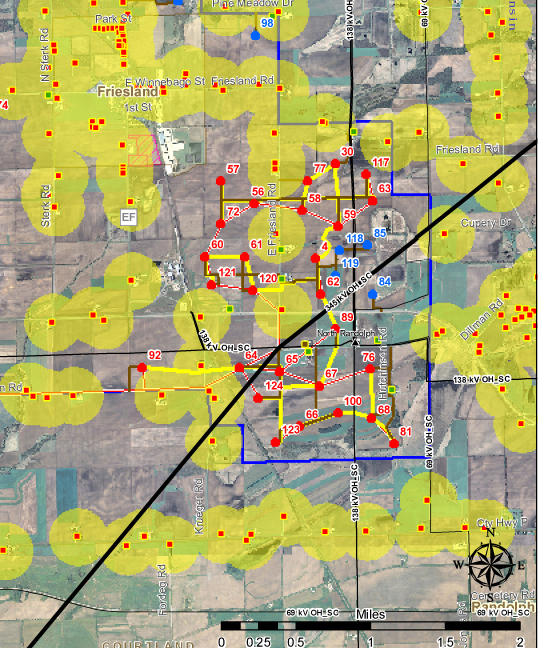
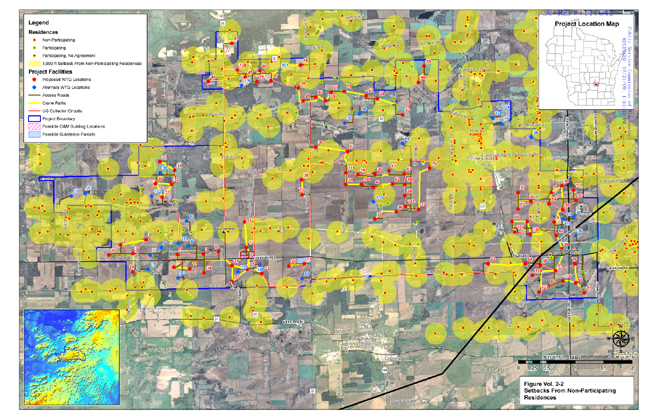
HOW MANY RESIDENTS WILL BE AFFECTED BY THE NEW WIND SITING RULES?
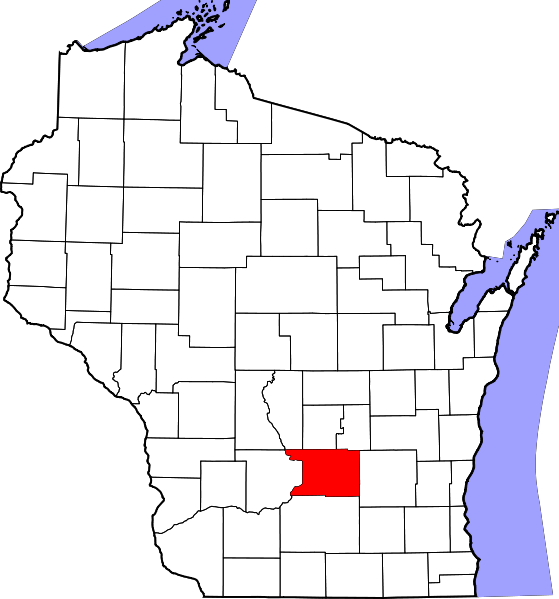
The red squares in the yellow circles on the map above represent non-participating homes in the WeEnergies Glacier Hills wind project currently under construction in Columbia County.
The larger red dots are the turbine locations. [Scroll down to see more detailed maps.]
The new wind rules adopted by the Public Service Commission have the same setbacks from homes as were used for this project.
One difference is the PSC required WeEnergies to offer to buy two homes in the project because seven turbines were to be located within half a mile.
The new rules do not include this sort of protection. Chairman Eric Callisto said by law homeowners have the right to sue the wind developer/owner and he felt that was all the protection they needed.
Although Wisconsin wind farm residents who have been forced to try to sell their homes because of turbine noise and shadow flicker have found no buyers, local wind developers say 400 to 500 foot tall wind turbines located less than 1500 feet a home have no impact on property values.
[CLICK HERE to watch Wisconsin Eye video: During the panel discussion, WPPI vice president Dan Ebert and WeEnergy's head of wind development Andy Hesselbach explain why turbines do not affect property value. ]
Or CLICK HERE to link directly to the Wisconsin Eye 'Newsmakers' feature "Future of Wind Energy"
Developers also say Wind energy is the cheapest way to get renewable energy and cite surveys which indicate stong public support for wind power.
Wind siting council member and Wisconsin realtor Tom Meyer weighs in on the matter.
This is not a question of whether or not people like, or favor "wind" as the lobbyists try to argue. Everyone likes wind, sun, water, earth.
The issue is this: The total cost of generating energy by the use of 400 and 500 foot tall turbines in Wisconsin’s rural communities.
Developers admit that they cannot get investors, who are primarily foreign investors, to put their money up unless the costs of access to the land are depressed.
To get the biggest area to install the highest number of 400 to 500 foot tall turbines, the developer needs to have the greatest access to the most land and compensate the fewest people with the least dollars.
The developer does not need your land, he needs to get one foot [away] from your land.
Every foot the developer is made to move away from a landowner whom he does not have to compensate, adds cost to the developer and reduces the bottom line to investors.
Every dollar spent to gain access to the right to disturbing the peace of a landowner reduces the bottom line.
For wind turbines to be profitable, the industry could improve the technology or depress the cost of access to the land.
By their actions, they prove they believe depressing land costs is more favorable than investing in improving the technology.
Their answer to improved technology is taller and more intrusive. That's not a real solution.
If the turbine can't produce energy without imposing on neighbors, there is no reason to spoil the earth, and threaten the water, and block the sun, to catch the wind.
-Tom Meyer
Wisconsin Wind Siting Council Member
NOTE: Tom Meyer was one of the authors of the minority report from the wind siting council. The report details why some council members strongly disagree with the recommendations sent forth to the Public Service Commission.
CLICK HERE to download pictures of homes in Wisconsin wind projects.
Below, detail maps of non-participating residences in WeEnergies Glacier Hills Project
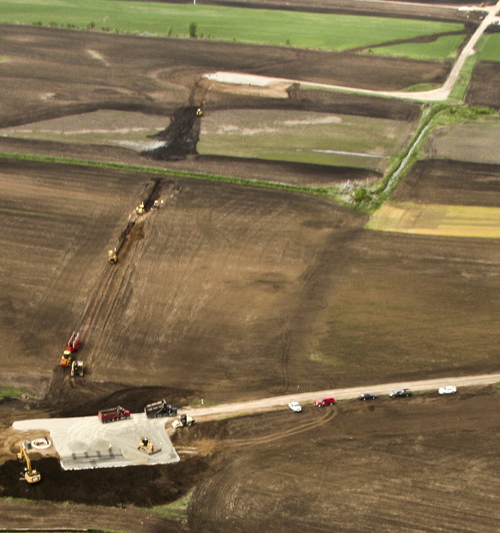
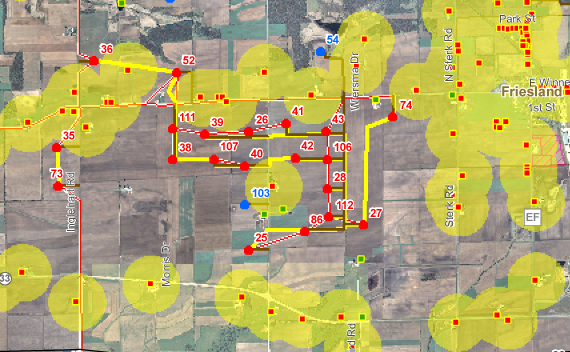
NOTE FROM THE BPWI RESEARCH NERD:
The project mentioned below was sited with the same setbacks and noise limits used to site the We Energies Glacier Hills project. (Detail maps above)
NO EASY SOLUTION TO WIND TURBINE PROBLEM
The Associated Press
VINALHAVEN, Maine (AP) -- The CEO of the electric cooperative that installed wind turbines on Maine's Vinalhaven island says there's disagreement over data suggesting they're too noisy.
Fox Island Wind CEO George Baker says his experts dispute the findings of a Department of Environmental Protection consultant who says the turbines violate nighttime noise limits.
State law sets a 45-decibel limit. Baker says his experts believe it was ambient noise from wind rustling through trees that exceeded 45 decibels, not the turbines themselves.
Baker says it'll be a difficult issue to resolve. He told The Associated Press on Tuesday that slowing the turbine blades to lower the noise level by a couple of decibels may not make appease critics. And lowering it further could hurt the economic viability of the project.

